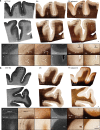Enhanced multiscale human brain imaging by semi-supervised digital staining and serial sectioning optical coherence tomography
- PMID: 39833166
- PMCID: PMC11746934
- DOI: 10.1038/s41377-024-01658-0
Enhanced multiscale human brain imaging by semi-supervised digital staining and serial sectioning optical coherence tomography
Abstract
A major challenge in neuroscience is visualizing the structure of the human brain at different scales. Traditional histology reveals micro- and meso-scale brain features but suffers from staining variability, tissue damage, and distortion, which impedes accurate 3D reconstructions. The emerging label-free serial sectioning optical coherence tomography (S-OCT) technique offers uniform 3D imaging capability across samples but has poor histological interpretability despite its sensitivity to cortical features. Here, we present a novel 3D imaging framework that combines S-OCT with a deep-learning digital staining (DS) model. This enhanced imaging modality integrates high-throughput 3D imaging, low sample variability and high interpretability, making it suitable for 3D histology studies. We develop a novel semi-supervised learning technique to facilitate DS model training on weakly paired images for translating S-OCT to Gallyas silver staining. We demonstrate DS on various human cerebral cortex samples, achieving consistent staining quality and enhancing contrast across cortical layer boundaries. Additionally, we show that DS preserves geometry in 3D on cubic-centimeter tissue blocks, allowing for visualization of meso-scale vessel networks in the white matter. We believe that our technique has the potential for high-throughput, multiscale imaging of brain tissues and may facilitate studies of brain structures.
© 2025. The Author(s).
Conflict of interest statement
Conflict of interest: The authors declare no competing interests.
Figures






Update of
-
Enhanced Multiscale Human Brain Imaging by Semi-supervised Digital Staining and Serial Sectioning Optical Coherence Tomography.Res Sq [Preprint]. 2024 Mar 21:rs.3.rs-4014687. doi: 10.21203/rs.3.rs-4014687/v1. Res Sq. 2024. Update in: Light Sci Appl. 2025 Jan 20;14(1):57. doi: 10.1038/s41377-024-01658-0. PMID: 38562721 Free PMC article. Updated. Preprint.
Similar articles
-
Enhanced Multiscale Human Brain Imaging by Semi-supervised Digital Staining and Serial Sectioning Optical Coherence Tomography.Res Sq [Preprint]. 2024 Mar 21:rs.3.rs-4014687. doi: 10.21203/rs.3.rs-4014687/v1. Res Sq. 2024. Update in: Light Sci Appl. 2025 Jan 20;14(1):57. doi: 10.1038/s41377-024-01658-0. PMID: 38562721 Free PMC article. Updated. Preprint.
-
Serial optical coherence microscopy for label-free volumetric histopathology.Sci Rep. 2020 Apr 21;10(1):6711. doi: 10.1038/s41598-020-63460-3. Sci Rep. 2020. PMID: 32317719 Free PMC article.
-
Blockface histology with optical coherence tomography: a comparison with Nissl staining.Neuroimage. 2014 Jan 1;84:524-33. doi: 10.1016/j.neuroimage.2013.08.072. Epub 2013 Sep 13. Neuroimage. 2014. PMID: 24041872 Free PMC article.
-
Methods and applications of full-field optical coherence tomography: a review.J Biomed Opt. 2022 May;27(5):050901. doi: 10.1117/1.JBO.27.5.050901. J Biomed Opt. 2022. PMID: 35596250 Free PMC article. Review.
-
Deep learning for artery-vein classification in optical coherence tomography angiography.Exp Biol Med (Maywood). 2023 May;248(9):747-761. doi: 10.1177/15353702231181182. Epub 2023 Jul 15. Exp Biol Med (Maywood). 2023. PMID: 37452729 Free PMC article. Review.
References
-
- Pistorio, A. L., Hendry, S. H. & Wang, X. Q. A modified technique for high-resolution staining of myelin. J. Neurosci. Methods153, 135–146 (2006). - PubMed
-
- Amunts, K. et al. BigBrain: an ultrahigh-resolution 3D human brain model. Science340, 1472–1475 (2013). - PubMed
-
- Yushkevich, P. A. et al. 3D mouse brain reconstruction from histology using a coarse-to-fine approach. Proc. 3rd Biomedical Image Registration (Utrecht: Springer, 2006).
Grants and funding
LinkOut - more resources
Full Text Sources

